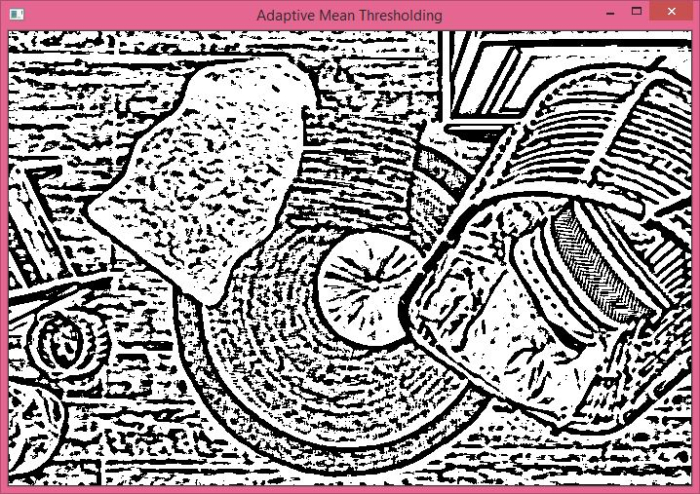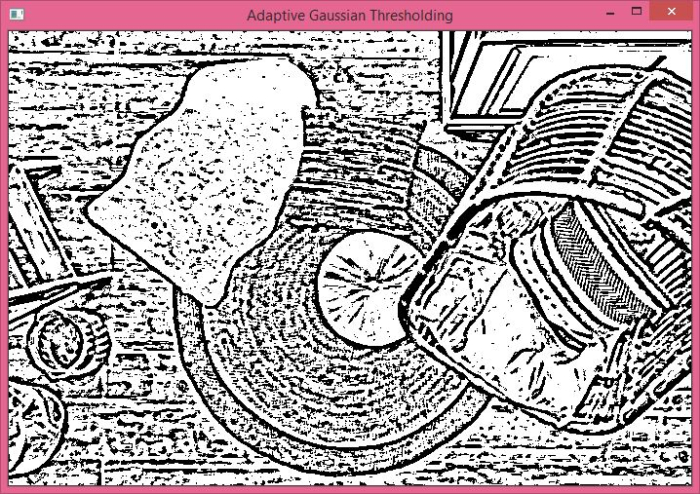
 Data Structure
Data Structure Networking
Networking RDBMS
RDBMS Operating System
Operating System Java
Java MS Excel
MS Excel iOS
iOS HTML
HTML CSS
CSS Android
Android Python
Python C Programming
C Programming C++
C++ C#
C# MongoDB
MongoDB MySQL
MySQL Javascript
Javascript PHP
PHP
- Selected Reading
- UPSC IAS Exams Notes
- Developer's Best Practices
- Questions and Answers
- Effective Resume Writing
- HR Interview Questions
- Computer Glossary
- Who is Who
How to perform adaptive mean and gaussian thresholding of an image using Python OpenCV?
Adaptive thresholding is a kind of thresholding technique. There are other types of thresholding techniques such as simple thresholding that uses a global threshold value. But using a global threshold value is not a good idea for an image having different lighting conditions in different areas.
Adaptive thresholding calculates the threshold value for a small region in the image. So we have different threshold values for different regions in the image which gives better results in comparison to the simple thresholding technique.
There are three special parameters: adaptive_method, block_size and const. See the syntax given below.
Syntax
cv2.adaptiveThreshold(img, max_val, adaptive_method, thresh_type, block_size, const)
Parameters
img ? Input gray scale image. It's a numpy.ndarray.
max_valu ? Maximum value to be assigned to a pixel.
adaptive_method ? It decides how thresholding value is calculated. There are two different adaptive thresholding methods ?
cv2.ADAPTIVE_THRESH_MEAN_C ? In this method, threshold value is the mean of neighborhood area.
cv2.ADAPTIVE_THRESH_GAUSSIAN_C ? In this method, threshold value is the weighted sum of neighborhood values where weights are a gaussian window.
thresh_type ? The type of thresholding to be applied.
block_size ? Decides the size of the neighborhood area.
const ? A constant subtracted from the mean or weighted mean calculated.
Output ? It returns the threshold
Let's understand the Adaptive Mean thresholding and Adaptive Gaussian thresholding with the help of a couple of Python examples.
Input Image:
We will use this image as the input file in the following examples.

Example 1: Adaptive Mean Thresholding
In this program, we apply adaptive thresholding on the input image using cv2.ADAPTIVE_THRESH_MEAN_C as an adaptive method. We use block_size=11 and const=2. We use Binary thresholding as thresh_type.
import cv2 # Read the input RGB image as a Gray Scale image img = cv2.imread('floor.jpg',0) # apply median blur img = cv2.medianBlur(img,5) # apply adaptive mean thresholding th = cv2.adaptiveThreshold(img,255,cv2.ADAPTIVE_THRESH_MEAN_C, cv2.THRESH_BINARY,11,2) # display the output image cv2.imshow("Adaptive Mean Thresholding", th) cv2.waitKey(0) cv2.destroyAllWindows()
Output
When you run the above program, it will produce the following output window ?

The above output shows the image after applying Adaptive Mean Thresholding.
Example 2: Adaptive Gaussian Thresholding
In this program, we apply adaptive thresholding on the input image using cv2.ADAPTIVE_THRESH_GAUSSIAN_C as an adaptive method.
We use block_size=11 and const=2. We use Binary thresholding as thresh_type.
import cv2 # Read the input RGB image as a Gray Scale image img = cv2.imread('floor.jpg',0) # apply median blur img = cv2.medianBlur(img,5) # apply adaptive mean thresholding th = cv2.adaptiveThreshold(img,255,cv2.ADAPTIVE_THRESH_GAUSSIAN_C, cv2.THRESH_BINARY,11,2) # display the output image cv2.imshow("Adaptive Gaussian Thresholding", th) cv2.waitKey(0) cv2.destroyAllWindows()
Output
When you run the above program, it will produce the below output.

The above output shows the image after applying Adaptive Gaussian Thresholding.

